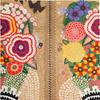POWER AND PROTECTION, Islamic Art and the Supernatural
- OXFORD, United Kingdom
- /
- September 28, 2016
Ashmolean Museum, University of Oxford, will present POWER AND PROTECTION, Islamic Art and the Supernatural, from October 20, 2016–January 15, 2017.
Showcasing over a hundred spectacular objects from Morocco to China, POWER AND PROTECTION is the first major exhibition to explore the supernatural in the art of the Islamic world. Within Islamic societies, people of all backgrounds have engaged in fascinating and sometimes controversial practices such as the casting of horoscopes and the interpretation of omens.
POWER AND PROTECTION includes objects and works of art from the 12th to the 20th centuries which have been used as sources of guidance and protection in both the private sphere and in dramatic events such as battles and royal births. Amongst the displays are dream-books, talismanic clothing and jewel-encrusted amulets. This is an unmissable chance to see works of breathtaking quality and astonishing scale, many of which have never before been seen in public.
Belief in the supernatural and the practice of divination have held a place in people’s lives across all times and cultures. In Islam, as in all religions, such beliefs and practices have often merged and been integrated into popular religion. Everyday objects and luxury items abound, showing how these practices were used at all levels of society around the Islamic world. The exhibition opens with a gallery of exquisite objects associated with astrology. One of the highlights is the Horoscope of Prince Iskandar (1384–1415), grandson of Timur (or ‘Tamburlaine’). Created in 1411 when the prince was an adult, the horoscope was manipulated to suggest celestial support for Iskandar’s political aims. It is also an extraordinary work of art - with images of planets and signs of the zodiac set in a rich blue background with gold decoration - which demonstrates the skills of the royal workshop of illuminators, gilders, calligraphers and paper-makers.
The opening section of the exhibition also explores geomancy or ‘the science of sand’ – a technique that interprets marks made in the earth. A particular highlight is an object that can be described as a 13th-century ‘computer’ designed to calculate a person’s fortune using circular dials and sliding arcs which help produce a geomantic reading. Once the dials were turned the geomancer could interpret the alignment of the dots within the instrument and thereby provide answers to the client’s questions, perhaps predicting the sex of an unborn child or discovering the infidelity of a spouse. Dated 1241–2 and signed by Muhammad ibn Khutlukh al-Mawsili, a craftsman who worked in Mosul, Damascus and Cairo, the device is completely unique and there is no evidence of a comparable object from any culture.
The exhibition goes on to examine the power of the written word, particularly the Qur’an. A display of stunning ceremonial objects, military equipment and medical tools reveal how the Holy Book of Islam could be used as a protection and cure. This includes a group of Turkish talismanic shirts (16th–18th centuries) entirely covered with Qur’anic passages which were worn for protection in battle or during times of illness; a huge 17th-century battle standard or banner (over three metres tall) from Deccan in PRESS RELEASE 28 September 2016, for immediate release: India; and an exceptional full set of steel armour (from 18th-century Iran) inscribed with holy verses and decorated with gold inlay. Centre-stage in this gallery are two pages from a monumental 14th-century Qur’an from Egypt illuminated in gold and lapis lazuli, each page measuring a staggering 78 by 48 cm. When it was still intact, the book would have weighed hundreds of pounds, requiring several men to lift it.
The final gallery focuses on the range of personal amulets and talismans created to harness and channel protective and healing powers. Here we have miniature Qur’ans with pages just a couple of centimetres wide which could be worn on a chain or carried in a pocket, as well as contemporary amulets from the shrine of Eyüp in Istanbul. Amulets in the form of jewellery have prayers and symbols engraved into precious stones that have their own specific powers, each combination tailored to an individual’s need. These objects come from countries as diverse as Nigeria, Turkey, Egypt, Iran, Iraq, India and Indonesia.
Imam Monawar Hussain, Founder, The Oxford Foundation, says: ‘POWER AND PROTECTION brings together the most beautiful array of Islamic objects and works of art which illustrate an aspect of the lived experience of many Muslims. In sharing this aspect of the Islamic tradition - one that is common across many different religions - at a time of such misunderstandings about Islam, I am convinced that this exhibition will help to deepen and enrich people’s appreciation of our faith.’

270x400_c.jpg)






_-Closing-the-Distance_100x100_c.jpg)









